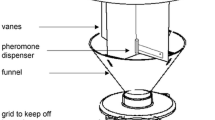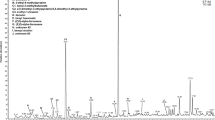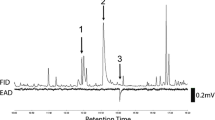Abstract
Gas chromatographic–electroantennographic detection (GC–EAD) analysis showed that male antennae of the green lacewing, Chrysopa nigricornis Burmeister, the most common lacewing species in the U.S. Pacific Northwest, consistently responded to two compounds in thoracic extracts of conspecific males: 1-tridecene and (1R,2S,5R,8R)-iridodial. These compounds were not detected in extracts of the abdominal cuticle, and no other antennally active compounds were found in the abdominal samples. In field-trapping experiments, traps baited with iridodial significantly attracted large numbers of C. nigricornis males (both western and eastern forms) during summer and early fall, plus a few individuals of conspecific females only in early fall. Iridodial also attracted males of the goldeneyed lacewing, C. oculata Say, and, to a lesser extent, C. coloradensis Banks males. Methyl salicylate (MS), reported as an attractant for both sexes of C. nigricornis and C. oculata, was inactive by itself at the concentration tested in our study, but in a few instances slightly enhanced the responses of Chrysopa spp. to iridodial. However, MS alone and its binary blend with iridodial seemed to attract the hoverfly, Metasyrphus americanus (Weidemann). 2-Phenylethanol, a reported attractant for another lacewing, Chrysoperla plorabunda (Fitch) [=carnea (Say)], did not capture any lacewings. Our assays indicated that the lacewing pheromone, iridodial, loaded onto either rubber septa or as a binary blend with MS in polyethylene bags could last at least 5 wk in the field during the summer season. Based on this study, a new attractant system for green lacewings is being developed for both domestic and international markets.






Similar content being viewed by others
References
Agnew, C. W., Sterling, W. L., and Dean, D. A. 1981. Notes on the Chrysopidae and Hemerobiidae of Eastern Texas with keys for their identification. Southwest. Entomology 4(Suppl):1–20.
Aldrich, J. R. 1999. Predators: Pheromones and kairomones, pp. 357–381, in R. J. Hardie and A. K. Minks (eds.). Pheromones of Non-lepidopteran Insects Associated with Agricultural Plants. CAB International Publishing, Wallingford, UK.
Baker, T. C., Obrycki, J. J., and Zhu, J. W. 2003. Attractants of beneficial insects. U. S. Patent no. 6,562,332.
Boo, K. S., Chung, I. B., Han, K. S., Pickett, J. A., and Wadhams, L. J. 1998. Response of the lacewing Chrysopa cognata to pheromones of its aphid prey. J. Chem. Ecol. 24:631–643.
Boo, K. S., Kang, S. S., Park, J. H., Pickett, J. A., and Wadhams, L. J. 2003. Field trapping of Chrysopa cognata (Neuroptera: Chrysopidae) with aphid sex pheromone components in Korea. J. Asia-Pacific Entomol. 6:29–36.
Byers, J. A. 1991. BASIC algorithms for random sampling and treatment randomization. Comput. Biol. Med. 21:69–77.
Chauhan, K. R., Zhang, Q.-H., and Aldrich, J. R. 2004. Iridodials: Enantiospecific synthesis and stereochemical assignment of the pheromone for the goldeneyed lacewing, Chrysopa oculata. Tetrahedron Lett. 45:3339–3340.
Flint, H. M., Salter, S. S., and Walters, S. 1979. Caryophyllene: An attractant for the green lacewing Chrysopa carnea. Environ. Entomol. 8:1123–1125.
Henry, C. S. 1979. Acoustical communication during courtship and mating in the green lacewing Chrysopa carnea (Neuroptera: Chrysopidae). Ann. Entomol. Soc. Am. 72:68–79.
Henry, C. S. 1980a. The importance of low frequency substrate-borne sounds in lacewing communication (Neuroptera: Chrysopidae). Ann. Entomol. Soc. Am. 73:617–621.
Henry, C. S. 1980b. Acoustical communication in Chrysopa rufilabris (Neuroptera: Chrysopidae) a green lacewing with two distinct calls. Proc. Entomol. Soc. Wash. 82:1–8.
Henry, C. S. 1980c. The courtship call of Chrysopa downesi Banks (Neuroptera: Chrysopidae): Its evolutionary significance. Psyche 86:291–297.
Henry, C. S. 1982. Reproductive and calling behavior in two closely related sympatric lacewing species, Chrysopa oculata and Chrysopa chi (Neuroptera: Chrysopidae). Proc. Entomol. Soc. Wash. 84:191–203.
Hooper, A. M., Donato, B., Woodcock, C. M., Park, J. H., Paul, R. L., Boo, K. S., Hardie, J., and Pickett, J. A. 2002. Characterization of (1R,4S,4aR,7S,7aR)-dihydronepetalactol as a semiochemical for lacewings, including Chrysopa spp. and Peyerimhoffina gracilis. J. Chem. Ecol. 28:849–864.
James, D. G. 2003a. Field evaluation of herbivore-induced plant volatiles as attractants for beneficial insects: methyl salicylate and the green lacewing, Chrysopa nigricornis. J. Chem. Ecol. 29:1601–1609.
James, D. G. 2003b. Synthetic herbivore-induced plant volatiles as field attractants for beneficial insects. Environ. Entomol. 32:977–982.
James, D. G. 2006. Methyl salicylate is a field attractant for the goldeneyed lacewing, Chrysopa oculata. Biocontrol Sci. Technol. 16:107–110.
James, D. G. and Price, T. S. 2004. Field testing of methyl salicylate for recruitment and retention of beneficial insects in grapes and hops. J. Chem. Ecol. 30:1613–1628.
McElvain, S. M., Bright, R. D., and Johnson, P. R. 1941. The constituents of the volatile oil of catnip. I. Nepetalic acid, nepetalactone, and related compounds. J. Am. Chem. Soc. 63:1558–1563.
Mendel, Z., Dunkelblum, E., Branco, M., Franco, J. C., Kurosawa, S., and Mori, K. 2003. Synthesis and structure–activity relationship of diene modified analogs of Matsucoccus sex pheromones.Naturwissenschaften 90:313–317.
New, T. R. 1975. The biology of Chrysopidae and Hemerobiidae (Neuroptera) with reference to their usage as biocontrol agents: a review. Trans. R. Entomol. Soc. Lond. 127:115–140.
Penny, N. D., Tauber, C. A., and De Leon, T. 2000. A new species of Chrysopa from western North America with a key to North American species (Neuroptera: Chrysopidae). Ann. Entomol. Soc. Am. 93:776–784.
Principi, M. M. and Canard, M. 1984. Feeding habits [Chrysopidae]. Ser. Entomol. 27:76–92.
Ridgway, R. L. and Murphy, W. L. 1984. Biological control in the field, pp. 220–228, in M. Canard, Y. Semeria, and T. R. New (eds.). Biology of Chrysopidae. Dr W. Junk Publishers, The Hague, the Netherlands.
Tauber, M. J., Tauber, C. A., Daane, K. M., and Hagen, K. S. 2000. Commercialization of predators: Recent lessons from green lacewings (Neuroptera: Chrysopidae: Chrysoperla). Am. Entomol. 46:26–38.
Tulisalo, U. 1984. Biological control in the green house, pp. 228–233, in M. Canard, Y. Semeria, and T. R. New (eds.). Biology of Chrysopidae. Dr W. Junk Publishers, The Hague, the Netherlands.
Zar, J. H. 1984. Biostatistical Analysis. Prentice Hall, Englewood Cliffs, NJ.
Zhang, Q.-H., Chauhan, K. R., Erbe, E. F., Vellore, A. R., and Aldrich, J. R. 2004. Semiochemistry of the goldeneyed lacewing Chrysopa oculata: Attraction of males to a male-produced pheromone. J. Chem. Ecol. 30:1849–1870.
Zhang, Q.-H., Schlyter, F., and Birgersson, G. 2000. Bark volatiles from nonhost angiosperm trees of spruce bark beetle, Ips typographus L. (Coleoptera: Scolytidae): Chemical and electrophysiological analysis. Chemoecology 10:69–80.
Zhang, Q.-H., Sheng, M. L., Chen, G. F., Aldrich, J. R., and Chauhan, K. R. 2006. Iridodial: A powerful attractant for the green lacewing, Chrysopa septempunctata (Neuroptera: Chrysopidae). Naturwissenschaften 93:461–465.
Zhu, J. W., Cossé, A. A., Obrycki, J. J., Boo, K. S., and Baker, T. C. 1999. Olfactory reactions of the twelve-spotted lady beetle, Coleomegilla maculata and the green lacewing, Chrysoperla carnea to semiochemicals released from their prey and host plant: Electroantennogram and behavioral responses. J. Chem. Ecol. 25:1163–1177.
Zhu, J. W., Obrycki, J. J., Ochieng, S. A., Baker, T. C., Pickett, J. A., and Smiley, D. 2005. Attraction of two lacewing species to volatiles produced by host plants and aphid prey. Naturwissenschaften 92:277–281.
Acknowledgments
We thank Dr. Oliver S. Flint, Jr. (Section of Entomology, Smithsonian Institution, Washington D.C.) and Dr. N. D. Penny (Department of Entomology, California Academy of Sciences, San Francisco, CA) for identifications of lacewings and other insect species; and Mr. Fallstrom, Mr. Christensen, Mr. Florianovich, and Mr. Rosengrant (in Spokane, WA) for allowing us to carry out our field-trapping experiments on their property.
Author information
Authors and Affiliations
Corresponding author
Rights and permissions
About this article
Cite this article
Zhang, QH., Schneidmiller, R.G., Hoover, D.R. et al. Male-Produced Pheromone of the Green Lacewing, Chrysopa nigricornis . J Chem Ecol 32, 2163–2176 (2006). https://doi.org/10.1007/s10886-006-9137-5
Published:
Issue Date:
DOI: https://doi.org/10.1007/s10886-006-9137-5




